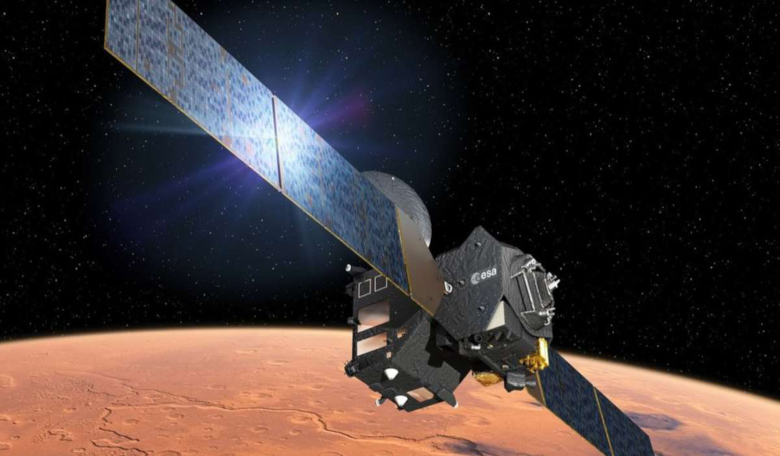A ‘glowing’ thin green layer of gas found on Earth near the poles, which also exists 90 kilometres above ground in the dayside atmosphere has now also been found on Mars - a finding which has so far eluded detection on other planets.
On Earth, from time to time, the planet’s inhabitants are treated to spectacular shows of luminescence that light up the night sky predominantly at mid to high latitudes.
We know them as auroras and they are caused by the interaction of the solar wind (charged particles flowing from the Sun) with a planet’s magnetic field.
However auroras are not the only light phenomena to grace the skies. On Earth we have other faint emissions of light that pervade the skies day and night, called dayglow and nightglow respectively.
These attenuated gaseous layers have a relatively steady presence and don’t come and go in a fleeting manner like auroras.
They are also generated by the interaction of solar radiation with molecules in the upper atmosphere – not with a magnetic field – and occur between about 80 and 120 km over middle and low latitudes. Auroras on the other hand occur at higher elevations.
Both forms of glow rely on sunlight striking certain atoms or molecules, which gives them excess energy. Depending on which atom or molecule the sunlight hits, will determine when the excess energy is released.
Dayglow emission is light that is released straight away at the same or slightly longer wavelength as the light that was absorbed, whereas nightglow emission is energy released several hours later after a molecule has been ripped apart and then later reformed.
Atmospheric scientists frequently observe emissions from hydroxyl (OH) and oxygen (O2) molecules and from sodium (Na) and oxygen (O) atoms in Earth’s skies and it is this latter atom, oxygen, that gives terrestrial auroras a greenish hue when it gets excited. This is because it emits light at wavelengthsaround 558 nanometers (nm), which corresponds to green light in the visible portion of the electromagnetic spectrum.
Whilst it might appear everywhere in our atmosphere as green-light emission, so far, scientists have yet to spot this type of visible light on another planet. Until now.
Using the ultraviolet and visible spectrometer (UVIS) instrument on board the European Space Agency’s ExoMars Trace Gas Orbiter (TGO), a team of European astronomers have now spotted this elusive green line dayglow emission on Mars.
Predicted to exist about 40 years ago, scientists have been scouring the spectrum looking for the ‘green’ atomic oxygen emission since then. They have found other types of dayglow emission, but this light was UV light, not visible light.
Thanks to UVIS, which is part of the Nadir and Occultation for Mars Discovery (NOMAD) suite of instruments on TGO, that has the capability to detect light in the 200–650 nm spectral range, a team headed by J.-C. Gérard at Université de Liège, Belgium have now found it.
Discovered during observations made between 24 April and 1 December 2019, the emission has helped Gérard and colleagues calculate an important ratio between visible and ultraviolet emissions using simultaneous measurement of two oxygen lines; a feat which is difficult even in a laboratory on Earth say Gérard and colleagues.
In contrast to visible light, calculations involving UV light are relatively straight forward, as different sources of light can be more easily distinguished from one another.
This is not the case with visible light emission features, which can get tangled up with sources you don’t particularly want to look at, such as radiation from the planet’s surface below.
Dayglow emission in particular is an important diagnostic tool to study the skies as it provides basic information about an atmosphere’s composition and its structure, along with atmospheric dynamics and energy deposition processes.
It even helps understand how dust storms play a part in atmospheric processes.
A planet-wide dust storm on Mars can heat the lower atmosphere and raise the altitude of the atmosphere - effects that can be seen in dayglow emission features.
The oxygen atoms that produce the green-line emission come from CO2 which is broken down by radiation from the Sun. CO2 is the main constituent of Mars' (and Venus') atmosphere but some regions of it are easier to study than others.
This is where UVIS will come in handy again say Gérard and colleagues, as they hope to use the lightweight instrument to understand CO2 in Mars' mesosphere; an atmospheric layer located between 40–100 kilometres above the planet's surface. The mesosphere is so cold, detections of CO2 ice clouds have been reported in this tenuous strip of atmosphere.
This is because CO2 within the mesosphere acts as a cooling agent by efficiently radiating heat into space and future UVIS dayglow observations "collected at different seasons, latitudes and local times will make it possible to characterise the CO2 density variations in the mesosphere", write the authors in their research paper submitted to Nature Astronomy today, a region otherwise not accessible by in situ measurements.
If you've enjoyed reading this article, please consider subscribing to ROOM Space Journal to gain immediate and full access to the latest magazine feature articles and receive your own print and/or digital copies of the quarterly ROOM magazine delivered electronically or direct to your door.











